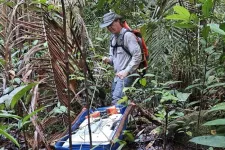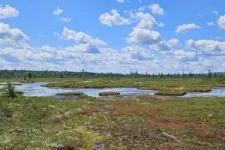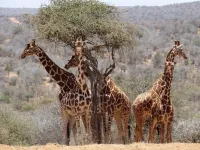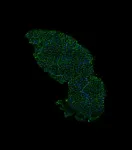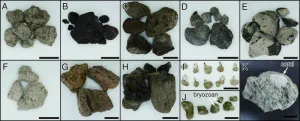(Press-News.org) Peatlands, a type of wetland found around the globe at all latitudes – from the Arctic to the tropics – are important ecosystems that store vast amounts of carbon. In fact, peatlands hold about one-third of the world’s soil carbon, despite covering only about 3% of the Earth’s land surface. When peatlands are disturbed or altered, they can release that carbon back into the atmosphere as greenhouse gases like methane. Peatlands are valuable ecosystems both for their biodiversity and for their role in regulating climate.
Researchers from Florida Atlantic University’s Charles E. Schmidt College of Science, in collaboration with Rutgers University and the University of Nevada, Reno, have received a $1.3 million grant from United States Department of Defense’s (DOD) Strategic Environmental Research and Development Program (SERDP), for a project focused on improving the accuracy of predicting carbon storage and gas emissions over a suite of peatlands covering a representative latitudinal gradient of relevance to the DoD, from Alaska to the Everglades. The goal is to reduce the uncertainty in these predictions by using an array of state-of-the-art geophysical methods that includes airborne ground-penetrating radar (GPR), and a new generation ground-based transient electromagnetic method (TEM).
A key part of the project titled, “Reducing Uncertainty in Carbon Pools and Free Phase Gas Fluxes in Peatland Ecosystems from Spatially Rich Geophysical Datasets,” is collecting rich, spatially detailed geophysical data to help more accurately estimate the amount of carbon stored in peatlands.
“Our project is designed to enhance our understanding of peat accumulation and gas distribution within the soil, particularly methane, by efficiently acquiring spatially rich datasets using novel geophysical approaches that includes deployment using drones,” said Xavier Comas, Ph.D., main principal investigator and a professor, FAU Department of Geosciences. “We will combine geophysical methods with direct soil and gas samples to explore the influence of factors such as soil physical properties, or gas composition and age, in regulating gas distribution and emissions. This understanding may help reduce uncertainty in overall gas flux estimates from peatlands in support of climate models.”
Additionally, the project will examine how specific environmental factors, such as the presence of permafrost or extreme weather events, affect the distribution and release of gases in these ecosystems. These peatlands will be selected across a range of latitudes, from Alaska to Florida, including sites in Maine and Minnesota.
“Our approach goes beyond traditional methods, such as drilling into the soil to collect core samples or estimating peat thickness based on surface elevation, and includes the use of drones,” said Comas. “Our methods will offer a better picture of how much carbon is stored and how gases are distributed, by improving on data collection efficiency that will allow for larger scale datasets and surveying in areas with challenging accessibility.”
Since drone-based GPR is still a relatively new technology, especially for carbon studies, this project also will help clarify how to best use this technology. The team will create clear guidelines that explain its limitations, challenges, and how to operate it effectively. This will make the technology more accessible to people who aren’t experts in the field, and it will contribute to the development of best practices within the Near-Surface Geophysics Inter-Society Committee, a group focused on advancing geophysical methods.
The research will take place at several field sites that are part of large federal research networks, including U.S. Forest Service experimental forests, the National Science Foundation’s long-term ecosystem research program (LTER), and the AmeriFlux monitoring network.
In addition to studying gas emissions, the research team will use their geophysical data to test a new model for understanding the development of raised bogs, which are a type of peatland. This model will help identify which areas of these bogs are most vulnerable to losing carbon (meaning the carbon can be easily drained away) versus areas that are safe from such loss, which will provide valuable information on how to better protect carbon stocks in these ecosystems.
“This project will significantly advance our understanding of ecosystem carbon management and provide a foundation for future research and action across the globe,” said Valery Forbes, Ph.D., dean, Charles E. Schmidt College of Science. “The development of practical guidelines for new technologies by Dr. Comas and collaborators empowers the scientific community to improve monitoring efforts worldwide. The results will have far reaching implications for climate policy, land use, and environmental conservation, particularly as we address the challenges posed from extreme weather events.”
- FAU -
About Florida Atlantic University:
Florida Atlantic University, established in 1961, officially opened its doors in 1964 as the fifth public university in Florida. Today, Florida Atlantic serves more than 30,000 undergraduate and graduate students across six campuses located along the Southeast Florida coast. In recent years, the University has doubled its research expenditures and outpaced its peers in student achievement rates. Through the coexistence of access and excellence, Florida Atlantic embodies an innovative model where traditional achievement gaps vanish. Florida Atlantic is designated as a Hispanic-serving institution, ranked as a top public university by U.S. News & World Report, and holds the designation of “R1: Very High Research Spending and Doctorate Production” by the Carnegie Classification of Institutions of Higher Education. Florida Atlantic shares this status with less than 5% of the nearly 4,000 universities in the United States. For more information, visit www.fau.edu.
END
Korean researchers will begin collaborating in earnest with the U.S. Department of Energy’s (DOE) Argonne National Laboratory (ANL) on semiconductor technology research.
Electronics and Telecommunications Research Institute (ETRI) announced on Jan. 6 (local time) that it has agreed to establish a mutual cooperation system to develop semiconductor technologies with Argonne National Laboratory in Illinois, USA.
ETRI has possessed the technology to develop and manufacture silicon detectors for high-energy particle detectors since the early 2000s ...
The gut bacteria of giraffes are not primarily determined by what they eat, but by the species they belong to. This is shown in a new study from Uppsala University and Brown University in which researchers have analysed the link between diet and gut flora in three giraffe species in Kenya. The study also provides new knowledge that can help secure the food supply of endangered giraffe species.
In a new study published in Global Ecology and Conservation, researchers have analysed the relationship between the diet and microbiome, or gut flora, of giraffes in Kenya. By sequencing plant and bacterial DNA from faecal samples, they were able to investigate both the bacterial composition ...
A group of Berlin researchers in collaboration with international scientists have found differences in heart inflammation caused by COVID-19, anti-COVID-19 vaccination, and non-COVID-19 myocarditis. The find paves the way for more personalized therapies, they report in “Nature Cardiovascular Research.”
Heart inflammation, or myocarditis, differs depending on its cause. A collaborative study led by Dr. Henrike Maatz, a scientist in the Genetics and Genomics of Cardiovascular Diseases lab of Professor Norbert Hübner at the Max Delbrück ...
A new service aimed at supporting older people who are starting to become frail, could reduce emergency hospital admissions by more than a third and save the NHS money, finds a new study led by UCL researchers.
The results from the clinical trial, published in The Lancet Healthy Longevity and funded by the National Institute for Health and Care Research (NIHR), evaluated the effect and cost-effectiveness of a new service, consisting of six personalised home-based visits from a support worker, tailored to each person to identify what they need to stay well and independent.
Interventions ...
Physical activity may help colon cancer survivors achieve long-term survival rates similar to those of people in the general population, according to a recent study published by Wiley online in CANCER, a peer-reviewed journal of the American Cancer Society.
Individuals with colon cancer face higher rates of premature mortality than people in the general population with matched characteristics such as age and sex. To assess whether exercise might reduce this disparity, investigators analyzed data from two posttreatment trials in patients with stage 3 colon cancer, with a total of 2,875 patients who self-reported ...
NEW YORK, NY (Feb. 24, 2025)--A new study, led by researchers at Columbia University, suggests it is easy for youths to purchase cannabis from unlicensed dispensaries in New York City, despite state laws that bar access to recreational cannabis to those under age 21.
“Regulation to restrict access in this age group is based on evidence that cannabis affects working memory, brain development, and increases addiction risk when used at an early age,” says Ryan Sultán , an assistant professor ...
Tokyo, Japan – Researchers from Tokyo Metropolitan University have carried out an unprecedentedly detailed survey of pumice rafts in the aftermath of the 2021 Fukutoku-Oka-no-Ba volcanic eruption in Japan. Using samples from 213 different locations, they considered raft density, the size and roundness of individual pumice, and biological species attached. Their findings revealed three phases in the evolution of drift pumice, involving rounding, fragmentation, and the diversification of attached biological organisms over time.
It is said that 85% of volcanic eruptions happen underwater. While their cousins on land might seem more vivid, the effects of underwater eruptions can be just as ...
Historically, access to geothermal energy has hinged on real estate’s famously three most important factors: location, location, and location. Because conventional geothermal power plants require hot, permeable rocks and plenty of underground fluid, use of the technology has been limited mostly to places with recent volcanism, such as Japan, New Zealand, the Philippines, Kenya, El Salvador, Iceland, and the western United States.
Over the past 50 years, however, techniques originally developed for oilfields and adapted for “enhanced geothermal systems” (EGS) have offered the promise ...
Many Medicare patients with advanced cancer receive potentially aggressive treatment at the expense of supportive care, according to a study that analyzed Medicare records.
The study, published in JAMA Health Forum, examined the quality of end-of-life care among 33,744 Medicare decedents. The study involved patients of diverse ethnic backgrounds, age 66 or older who died from breast, prostate, pancreatic or lung cancers.
Overall, claims records showed that 45% of the patients experienced potentially ...
As traditional candles burn, they can contribute to indoor air pollution by emitting volatile compounds and smoke, which may pose inhalation risks. Scented wax melts are often marketed as safer alternatives to candles because they’re flame- and smoke-free. But in a study in ACS’ Environmental Science & Technology Letters, researchers describe how aroma compounds released from the melted wax can react with ozone in indoor air to form potentially toxic particles.
Previous research has shown that scented wax melts emit more airborne scent compounds than traditional candles. The ...
